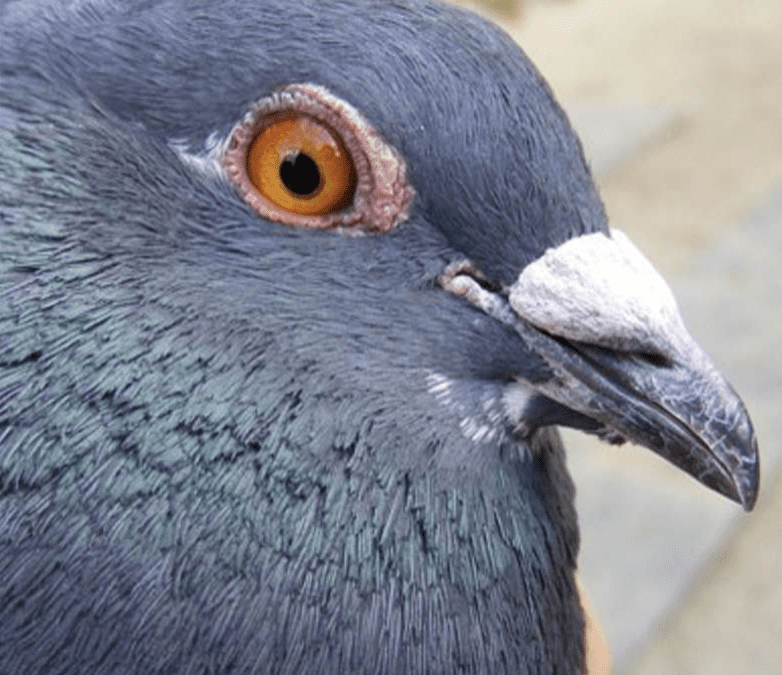
by Pigeon Patrol | Apr 26, 2021 | Columbidae, Pigeon Spikes, Pigeons in the News, UltraSonic Bird Control
Many of us have heard of the Lost Battalion, and know some of the story. What is not commonly known is the role of a remarkable pigeon, named Cher Ami. That little bird became one of the greatest heroes of World War I.
Cher Ami at the Smithsonian Institution. (Photo by Armed Forces History, Division of History of Technology, National Museum of American History)
Cher Ami was one of almost 600 carrier pigeons employed by the US Army Signal Corps during the First World War. Carrier pigeons were invaluable , in spite of the advances in communications technology during the war. Radios were not as reliable since they were large and still bound by delicate wires. It also was not always possible to lay new wires quickly, and often could be extremely dangerous. While not necessarily a popular form of communication, pigeons did prove a reliable one. The average homing pigeon can fly approximately fifty miles per hour, making them a quick method of communication. Still, these pigeons often proved popular targets to enemy gunfire despite their speed. In fact, German machine gunners trained diligently to both spot and kill these birds with their deadly MG 08s, which could fire over 500 rounds per minute. Pigeons could also be a very risky way to communicate, because if a pigeon was shot down, the message could easily be intercepted by enemy forces.
The US Army Signal Corps used some 600 pigeons in WW1.
It was during the Meuse-Argonne Offensive of 1918 where the carrier pigeon was finally recognized for its valiant efforts. On October 2nd, 1918, American soldiers from the 77th Division pushed too far into the Argonne Forest and became trapped behind German lines on the slopes of a hill. Cut off from reinforcements and supplies, roughly 550 men from the 306th, 307th, and 308th regiments under Major Charles Whittlesey held their ground against a far larger German force for several days. Far beyond radio range, the only way the Americans could communicate with their own lines was via carrier pigeon. However, it did not take long to realize that the skies were as dangerous as the ground. Trapped in a horrible meatgrinder of machine guns and rain, the Lost Battalion held their ground against vicious German attacks.
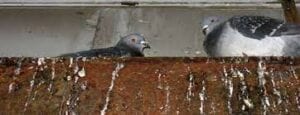
On October 4th, American heavy artillery started to bombard the Lost Battalion’s position on accident, killing thirty men as they held the line. Major Whittlesey and his men watched as bird after bird fell out of a sky torn apart by German fire. With supplies running out and casualties mounting rapidly, Major Whittlesey desperately sent out his last pigeon, Cher Ami, to the American lines with a note that simply read, “We are along the road parallel to 276.4. Our own artillery is dropping a barrage directly on us. For heaven’s sake, stop it.” With fire raining down on them from all sides, Cher Ami was now the last chance for the Lost Battalion to walk off that hill alive.
Capt John Carney, Cher Ami’s trainer, holds the feathered hero.
The brave bird flew straight into the German fire, dodging bullets as he went. However, his luck did not last for long. Cher Ami was hit in the chest soon after takeoff, as American soldiers watched in horror as their last hope hit the ground. Against all odds though, Cher Ami got up again! Wounded but still alive, the little bird took flight again, charging head-on into wave after wave of gunfire. By the end of the trip, he covered 25 miles in roughly half an hour. He arrived at base heavily wounded, but alive.
The Croix de Guerre with Palm military decoration of France, awarded to Cher Ami.
Army medics were able to save Cher Ami’s life, but his right leg was barely attached to his body and he was blind in one eye. However, because of Cher Ami’s delivery, the artillery stopped and took up new firing coordinates away from American lines. The next day, shells started to fall on German positions, relieving pressure on the bloodied 77th and the battle turned in America’s favor. On October 8th, one hundred and ninety-four men made it back to the American lines thanks to Cher Ami’s sacrifice.
For his part in saving the 77th Division, Cher Ami was awarded the Croix de Guerre, one of France’s highest military honors for his gallantry in the field. General John Pershing, commander of the American Expeditionary Force, said “There isn’t anything the United States can do too much for this bird.”
Cher Ami made it back to the United States in the care of its trainer, Capt John Carney. On June 13th, 1919, Cher Ami died at Fort Monmouth, New Jersey. However, Cher Ami’s body was preserved and presented to the American Government with honor. It is difficult to say how many families owe their existence to the sheer courage and self-sacrifice of one brave bird. Today, Cher Ami is on display at the Smithsonian Museum of American History to preserve his memory. Since then, his story has lived on in the hearts and minds of Americans across the decades, and his bravery will never be forgotten.
Pigeon Patrol Products & Services is the leading manufacturer and distributor of bird deterrent (control) products in Canada. Pigeon Patrol products have solved pest bird problems in industrial, commercial, and residential settings since 2000, by using safe and humane bird deterrents with only bird and animal friendly solutions. At Pigeon Patrol, we manufacture and offer a variety of bird deterrents, ranging from Ultra-flex Bird Spikes with UV protection, Bird Netting, 4-S Bird Gel and the best Ultrasonic and audible sound devices on the market today.
Voted Best Canadian wholesaler for Bird Deterrent products ten years in a row.
Contact us at 1- 877– 4– NO-BIRD, (604) 585-9279 or visit our website at www.pigeonpatrol.ca
Pigeon/Pigeon Patrol / Pigeons Roosting / Vancouver Pigeon Control /Bird Spikes / Bird Control / Bird Deterrent / Pigeon Deterrent? Surrey Pigeon Control / Pest /Seagull deterrent / Vancouver Pigeon Blog / Birds Inside Home / Pigeons in the cities / Ice Pigeons/ What to do about pigeons/ sparrows , Damage by Sparrows, How To Keep Raccoons Away, Why Are Raccoons Considered Pests/ De-fence / Pigeon Nesting/ Bird Droppings / Pigeon Dropping/ woodpecker control/ Professional Bird Control Company/ Keep The Birds Away/ Birds/rats/ seagull/pigeon/woodpecker/ dove/sparrow/pidgeon control/pidgeon problem/ pidgeon control/flying rats/ pigeon Problems/ bird netting/bird gel/bird spray/bird nails/ bird guard
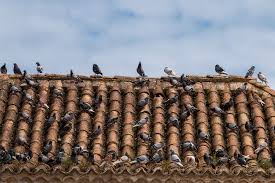
by Pigeon Patrol | Apr 26, 2021 | Bird Law, Pigeon Control, Pigeon Predators, Pigeon Spikes
Probably the second-worst thing that ever happened to pigeons was Woody Allen calling them “rats with wings” in 1980, prompting a bad reputation that the birds just haven’t been able to get rid of. (The worst thing that ever happened to pigeons was the extinction of the carrier pigeon in the late 1800s/early 1900s. These pigeons once existed in such multitudes, they would darken the sky for hours as they flew overhead; sadly, their sheer numbers led to a carefree attitude in hunting them, and they went from a population of millions to zero in a short time span.)
Contrary to popular belief, pigeons are quite interesting, useful animals. They were domesticated thousands of years ago (Darwin, in fact, was a little obsessed with pigeons), can be trained as athletes (called “racing pigeons”), mate for life (aww!), and have evolved to be able to digest a much wider variety of food than their ancestors. More recently, scientists in the U.S. and England have utilized pigeons to help collect data on air quality by strapping tiny, pigeon-sized backpacks onto the pigeons’ backs and tracking the data as the birds fly around.
They’re more reliable than your car’s GPS
Probably one of the most famous cool things about pigeons is their ability to always find their way home. You’ve probably heard of “homing pigeons” before, right? But how do they do it? Past studies have investigated the roles of olfactory cues, sun and magnetic compasses, and the use of long, linear landmarks such as roads, railway lines, and rivers. Interestingly enough, despite hundreds of years of research on the matter, there still doesn’t appear to be a consensus on how exactly pigeons have such an uncanny sense of direction.
In 2013, a study in the Journal of Experimental Biology found that homing pigeons use low-frequency sound waves, called infrasound waves, to make an acoustic mental map of their location. The researcher examined 14 years’ worth of data from 45,000 pigeons to determine that the only times the birds got lost were when these infrasound waves, due to wind or difficult terrain, were unable to reach the pigeons’ home loft. This sound block appears to have inhibited the birds’ ability to figure out their orientation relative to home, indicating that sound plays an important role in their ability to find their way home.
But in a 2015 study in Proceedings of the Royal Society B, scientists found that vision, too, plays a major role in homing pigeons’ abilities. The left and right halves of bird brains are thought to act more autonomously than ours, because they don’t have a corpus callosum, the part of the brain that passes information between brain hemispheres. So for this study, the researchers placed eye patches on first one, then the other, of the birds’ eyes to see how limited vision might affect their sense of direction. Two groups of birds were trained to return home, first with the left eye covered or first with the right eye covered. The pigeons formed new routes after switching eyes, meaning that their brain hemispheres do indeed learn and act independently.
It’s worth nothing that, despite having full use of both eyes and ears, plus the ability to read a map, I can recount multiple instances wherein I panicked because I was “lost,” only to find out I was within two or three blocks of home. Multiple instances, you guys. I would be a terrible pigeon.
They can detect cancer
So, pigeons have built-in GPSs. You still seem unimpressed. Well, did you know that pigeons can also detect cancer? Aha, now I’ve got your attention!
It’s true: a 2015 study in PLOS ONE found that pigeons, with a little training, can distinguish breast tissue from tumors on biopsy slides. The researchers showed 16 pigeons touchscreen images of microscope slides of either benign or malignant breast tissue, and within two weeks, the pigeons had achieved 85% accuracy in identifying malignancies. Interestingly, if the assessments of multiple pigeons on each slide were added together (the researchers called this “flock-sourcing,” which may be the cutest adaption of crowdsourcing I’ve ever seen), accuracy reached 99%. The pigeons had a harder time identifying suspicious masses in mammogram images, which, to be fair, is something doctors have trouble with too, even after of years of training.
Nonetheless, this suggests that pigeons could be used as trained medical image observers and could help researchers figure out better ways to train pathologists and computer systems by determining the impact of color, contrast, brightness, and image compression artifacts on diagnostic performance.
They’re highly intelligent
Which brings me back to my original point: pigeons are actually highly intelligent creatures. A 1995 study in the Journal of the Experimental Analysis of Behavior found that pigeons could distinguish between paintings by Monet and Picasso (though the study didn’t determine which artist the pigeons preferred, so we may never know if they’re more into cubism or impressionism). A 2008 study in Animal Cognition found that pigeons, like large-brained primates, recognize themselves in mirrors and videos.
In a study presented at the 2011 Society for Experimental Biology Annual Conference, researchers determined that feral, untrained pigeons can recognize individual people and are not fooled by a change of clothes. Two researchers, of similar build and skin color, wearing different-colored lab coats that covered most of their bodies, fed pigeons in a park. One of the researchers ignored the pigeons, whereas the other researcher shooed the pigeons away; in subsequent sessions, even when the “hostile” researcher acted neutrally toward the pigeons or switched lab coats with the other researcher, the pigeons recognized and avoided the “hostile” researcher.

Lest you think this is a one-off occurrence, a 2012 study in Avian Biology Research confirmed that pigeons can recognize a person they have encountered before, based strictly on facial characteristics. The researchers trained a group of pigeons to distinguish between photographs of familiar and unfamiliar objects. These pigeons, along with a control group that had not been trained, were then shown photographs of pairs of human faces, one familiar and one the pigeons had not previously seen. The trained birds were able to recognize and classify the familiar people using only their faces, whereas the birds without prior training failed.
So, to recap, pigeons can identify cancer, recognize human faces, and find their way home. Which leaves me with one burning question: do they also play fetch?
Pigeon Patrol Products & Services is the leading manufacturer and distributor of bird deterrent (control) products in Canada. Pigeon Patrol products have solved pest bird problems in industrial, commercial, and residential settings since 2000, by using safe and humane bird deterrents with only bird and animal friendly solutions. At Pigeon Patrol, we manufacture and offer a variety of bird deterrents, ranging from Ultra-flex Bird Spikes with UV protection, Bird Netting, 4-S Bird Gel and the best Ultrasonic and audible sound devices on the market today.
Voted Best Canadian wholesaler for Bird Deterrent products ten years in a row.
Pigeon/Pigeon Patrol / Pigeons Roosting / Vancouver Pigeon Control /Bird Spikes / Bird Control / Bird Deterrent / Pigeon Deterrent? Surrey Pigeon Control / Pest /Seagull deterrent / Vancouver Pigeon Blog / Birds Inside Home / Pigeons in the cities / Ice Pigeons/ What to do about pigeons/ sparrows , Damage by Sparrows, How To Keep Raccoons Away, Why Are Raccoons Considered Pests/ De-fence / Pigeon Nesting/ Bird Droppings / Pigeon Dropping/ woodpecker control/ Professional Bird Control Company/ Keep The Birds Away/ Birds/rats/ seagull/pigeon/woodpecker/ dove/sparrow/pidgeon control/pidgeon problem/ pidgeon control/flying rats/ pigeon Problems/ bird netting/bird gel/bird spray/bird nails/ bird guardContact us at 1- 877– 4– NO-BIRD, (604) 585-9279 or visit our website at www.pigeonpatrol.ca

by Pigeon Patrol | Feb 24, 2021 | Bird Deterrent Products, Bird Netting, Bird Spikes, Doves, Pigeon Control, Pigeon Spikes
![Building Product: No Knot Bird Netting - [10203b8] | ARCAT](https://www.arcat.com//photos/birdbgon/132024.jpg)
Why You Should Get Bird Netting
Are you a business owner or property owner that has a bird problem on your premises? Then this is the blog for you!
Here are reasons you should get bird netting!
Bird netting is set up to prevent birds from reaching certain areas, encouraging them to move on to an easier roosting place. Netting can keep birds off windowsills, rooftops, away from your ventilation and roof top air conditioning units. It can take a professional to know just where to place the netting so that it will be the most productive and the least noticeable for customers.
The benefits of using Bird Netting?
- Netting is a great solution against pretty much any type of birds, especially the likes of pigeons and gulls, sparrows and starlings, who are known to cause problems
- Bird netting is highly versatile and can be fitted to pretty much any size that you need to cover
- Bird netting protect structures
- Netting is environmentally safe and can withstand a wide range of environmental conditions
- Netting can last many years
- Netting is virtually invisible when installed correctly
Bird netting or anti-bird netting is a form of bird pest control. It is a net used to prevent birds from reaching certain areas.
Bird protection netting comes in a variety of shapes and forms, The most common is a small mesh (1 or 2 cm squares) either extruded and bi-oriented polypropylene or woven polyethylene.
The color most used is black (as the carbon black UV inhibitor offers the best protection against solar rays), but also bird netting may be available in other colors like white (usually white netting is woven or knitted and has an even smaller mesh size as it will serve as a double purpose anti-hail net for the protection of fruits during summer hail storms or late spring during flowering) or green (usually used in home gardening and mostly sold at retail outlets for the DIY farmers).
Source
Pigeon Patrol Products & Services is the leading manufacturer and distributor of bird deterrent (control) products in Canada. Pigeon Patrol products have solved pest bird problems in industrial, commercial, and residential settings since 2000, by using safe and humane bird deterrents with only bird and animal friendly solutions. At Pigeon Patrol, we manufacture and offer a variety of bird deterrents, ranging from Ultra-flex Bird Spikes with UV protection, Bird Netting, 4-S Gel and the best Ultrasonic and audible sound devices on the market today.
Contact us at 1- 877– 4– NO-BIRD, (604) 585-9279 or visit our website at www.pigeonpatrol.ca
Pigeon / Pigeon Patrol / Pigeons Roosting / Vancouver Pigeon Patrol / Bird Control / Surrey Pigeon Control / Pest / Vancouver Pigeon Blog / Birds Inside Home / Pigeons in the cities / Ice Pigeons/ What to do about pigeons/ most common types of sparrows , Damages Caused by Sparrows, How To Keep Raccoons Away, Why Are Raccoons Considered Pests?de-fence, Pigeon Nesting and Breeding Patterns and Behavior What Do I Do With a Bird Trapped in My Wall? Professional Bird Control Company Keep The Birds Away From Your Business Why Are Raccoons Considered Pests?
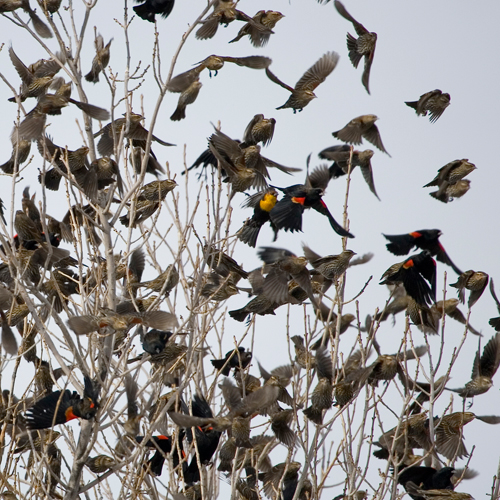
by Pigeon Patrol | Feb 9, 2021 | Animal Deterrent Products, Bird Deterrent Products, Bird Law, Bird Netting, Bird Spike, Bird Spikes, Pigeons, Raccoons
What Bird Are Considered To Be A Pest?
Pest Bird
The Canada goose, pigeons, starlings, seagulls and house sparrows are the most common pest birds in our area. Pest birds are responsible for millions of dollars of damage every year. Bird droppings are highly caustic and eat away at roofing and other structural material. They contaminate food, water, and anything they touch. They release airborne spores that can be inhaled by customers, workers and family members. They also carry disease-causing parasites, fleas, ticks, mites, lice and other biting insects.
Are They Dangerous
Pigeon’s droppings and nests are of medical concern because they have over 50 diseases associated with them. Some of these include histoplasmosis, chlamyiosis, and salmonella. Their droppings are also acidic and may mar many different surfaces. The Canada goose is aggressive at protecting its territory and airport safety is jeopardized as many airport bird strike collisions result from geese roosting in open areas near airports. House sparrows and starlings can be a major nuisance in urban areas due to their nesting, eating, and living habits. Gutters and drainage pipes clogged with sparrow or starling nests can back up and cause extensive water damage. Furthermore, numerous fires have been attributed to electrical shorts from machinery housing sparrow or starling nests.
How To Get Rid Of Them
Controlling these birds can be difficult. That’s why our services may include a combination of products and techniques. Corrective landscaping, barriers, and exclusion methods may all be used to rid your home or business of these nuisance birds. source
Can You DIY?
Due to the complexity of treatment and the time required, pigeons, Canada geese, and house sparrows are generally not a pest many people have success in eradicating on their own. Beware when purchasing products online, as many are not effective. Pesticides are not typically effective against birds and can be harmful to people and pets if they are misused or mixed improperly.
How Soon Can We Come?
Our customers are our top priority. The Pigeon Patrol team will help you as soon as we can
Are These Treatments Safe?
Pigeon Patrol uses the least amount of materials possible while still resolving the problem. We utilize natural products, baits, and mechanical means as a form of treatment whenever possible keeping you, your family, employees, and customers safe.
How To Prevent For The Future
Pest bird problems can be difficult to prevent. Many of our clients choose year-round service against pest birds for the protection of their home or business.
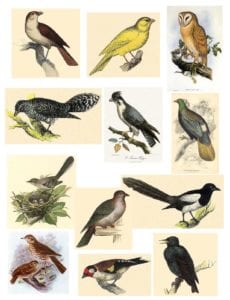
Pigeon Patrol Products & Services is the leading manufacturer and distributor of bird deterrent (control) products in Canada. Pigeon Patrol products have solved pest bird problems in industrial, commercial, and residential settings since 2000, by using safe and humane bird deterrents with only bird and animal friendly solutions. At Pigeon Patrol, we manufacture and offer a variety of bird deterrents, ranging from Ultra-flex Bird Spikes with UV protection, Bird Netting, 4-S Gel and the best Ultrasonic and audible sound devices on the market today.
Contact us at 1- 877– 4– NO-BIRD, (604) 585-9279 or visit our website at www.pigeonpatrol.ca
Pigeon / Pigeon Patrol / Pigeons Roosting / Vancouver Pigeon Patrol / Bird Control / Surrey Pigeon Control / Pest / Vancouver Pigeon Blog / Birds Inside Home / Pigeons in the cities / Ice Pigeons/ What to do about pigeons/ most common types of sparrows , Damages Caused by Sparrows, How To Keep Raccoons Away, Why Are Raccoons Considered Pests?de-fence, Pigeon Nesting and Breeding Patterns and Behavior What Do I Do With a Bird Trapped in My Wall? Professional Bird Control Company Keep The Birds Away From Your Business Why Are Raccoons Considered Pests?
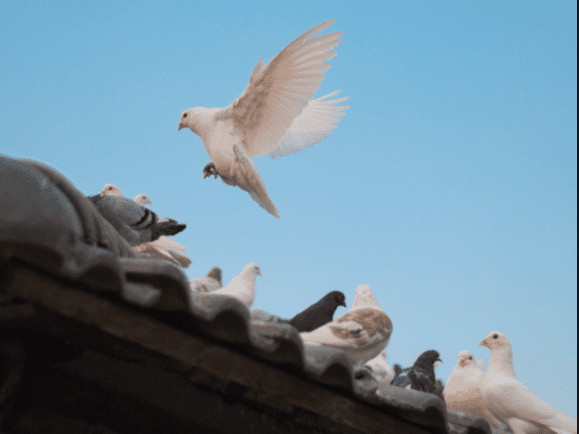
by Pigeon Patrol | Feb 9, 2021 | Animal Deterrent Products, Bird Deterrent Products, Bird Law, Bird Netting, Bird Spike, Bird Spikes, Pigeon Patrol's Services, Pigeon Spikes, Pigeons, UltraSonic Bird Control
Bird control technicians’ nightmare – what to do when we are asked to do the impossible? The straight answer is that there is really nothing we can do when pigeons land on your roof, but there is much more to know.
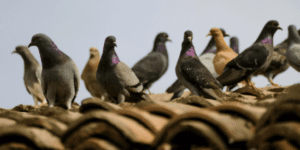
Many customers ask: “Why? Why my roof, what’s so special about my roof that they have to land there?” Believe it or not you are asking the right question: Why? Once you understand why, you will also understand why is it hard to provide a solution in this situation.
Almost always, the primary cause of such problem is the availability of food nearby, plenty of it on a regular basis. Probably someone is feeding the birds or there are lots of garbage in the area or open garbage bins/containers. They could also nest or roost in close proximity and simply they use your roof as a comfy perching spot having a nice vantage point over their feeding area.
What could we do? Install hundreds of feet of spikes on your roof? Put up scary owls? Maybe speakers on the roof peak? Unfortunately none of them are viable. It is simply not feasible to protect large, flat (horizontal or sloped) roof surfaces, such as the entire roof of a victorian house for example.
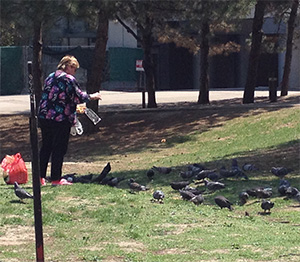
Lady feeding the pigeons in College Park – every day.
First, we need to find ways of eliminating food and water sources nearby. Then we must find their nesting/roosting areas – which will most likely be on another property, otherwise you would see them somewhere else on your house/building, (in which case it would be very easy to resolve the issue,– that provides sheltered structural configurations to establish a protected area where they can stay at night. Pigeons don’t see well at night and usually they go to their roosting spots before nightfall and stay there during the night.
If protecting these areas are not possible (because they are on someone else’s property) we can look at strategically installing Bird Spikes or exclusion Bird Netting or the combination of both, maybe Electric Tracks at critical areas to discourage them from landing on your roof.
You can see now that there aren’t any straightforward solutions in the case of house roof tops and that it is very time consuming to address the issue holistically. The best thing you can do is to call up a professional and get an opinion, you might have missed something that a pro will notice that could help resolve the issue.
source
Some other options for bird repellent would be the Ultrasonic Sound Repellent which makes noises that can only be heard by pigeons and scare them off with the sound or the laser beam which can be activated by movement or you can time when these lasers come on. These lasers are too strong for the pigeons vision to handle and they will fly elsewhere. You can purchase these here : https://www.pigeonpatrol.ca/product/laser/
Pigeon Patrol Products & Services is the leading manufacturer and distributor of bird deterrent (control) products in Canada. Pigeon Patrol products have solved pest bird problems in industrial, commercial, and residential settings since 2000, by using safe and humane bird deterrents with only bird and animal friendly solutions. At Pigeon Patrol, we manufacture and offer a variety of bird deterrents, ranging from Ultra-flex Bird Spikes with UV protection, Bird Netting, 4-S Gel and the best Ultrasonic and audible sound devices on the market today.
Contact us at 1- 877– 4– NO-BIRD, (604) 585-9279 or visit our website at www.pigeonpatrol.ca
Pigeon / Pigeon Patrol / Pigeons Roosting / Vancouver Pigeon Patrol / Bird Control / Surrey Pigeon Control / Pest /

by Pigeon Patrol | Feb 9, 2021 | Bird Law, Bird Netting, Bird Spike, Bird Spikes, Columbidae, Pigeon Patrol's Services, Pigeon Spikes
If you’re looking for the answer to the question “do anti bird spikes reduce pest bird problems?”, then you undoubtedly already have a problem with bird control. Birds are either landing or nesting on your property.
So lets see if bird spikes really work!
You need to look at why the birds are landing and possibly building a nest. Is it because you feed wild birds and other unwelcome species, such as feral pigeons or starlings, are having the lion’s share? Birds go to places where food is most abundant and easy to take. If you want to control what birds you attract to your garden, especially smaller ones, but not pigeons and starlings, make sure you only place food in feeding containers that make it virtually impossible for the larger birds to feed from. If there’s no readily available food, these larger birds will move on to somewhere else.
Secondly, if you have a bird control problem with the smaller birds then anti-bird spikes may not be effective in preventing them from landing and nesting. If you think about it logically, the smaller birds have feet which are designed to grab hold of small branches and twigs – spikes can give them this ideal landing perch.
However, larger birds, such as seagulls and pigeons don’t have feet adapted for landing on fine spiky branches and twigs and therefore anti bird spikes can be a very effective deterrent. If there are a vast numbers of birds, their droppings have been known to build-up on and around the spikes which then forms an ideal platform for them to build nests. SOURCE
Conclusion:
Anti-bird spikes can reduce pest bird control problems if you’re trying to humanely deter larger birds from landing or nesting. On the other hand, the spikes may be the ideal conditions for smaller birds; so you need to take a multi-faceted approach to control unwanted birds from making your property their home or landing site.
Do bird spikes hurt the birds? Bird and pigeon spikes do not hurt birds, they act as a visual and physical barrier. Bird spikes are a humane bird deterrent as the bird doesn’t come into direct contact with the bird spikes.
Pigeon Patrol Products & Services is the leading manufacturer and distributor of bird deterrent (control) products in Canada. Pigeon Patrol products have solved pest bird problems in industrial, commercial, and residential settings since 2000, by using safe and humane bird deterrents with only bird and animal friendly solutions. At Pigeon Patrol, we manufacture and offer a variety of bird deterrents, ranging from Ultra-flex Bird Spikes with UV protection, Bird Netting, 4-S Gel and the best Ultrasonic and audible sound devices on the market today.
Contact us at 1- 877– 4– NO-BIRD, (604) 585-9279 or visit our website at www.pigeonpatrol.ca
Pigeon / Pigeon Patrol / Pigeons Roosting / Vancouver Pigeon Patrol / Bird Control / Surrey Pigeon Control / Pest / Vancouver Pigeon Blog / Birds Inside Home / Pigeons in the cities / Ice Pigeons/ What to do about pigeons/ most common types of sparrows , Damages Caused by Sparrows, How To Keep Raccoons Away, Why Are Raccoons Considered Pests?de-fence, Pigeon Nesting and Breeding Patterns and Behavior What Do I Do With a Bird Trapped in My Wall? Professional Bird Control Company Keep The Birds Away From Your Business Why Are Raccoons Considered Pests? BIRD SPIKES WORK 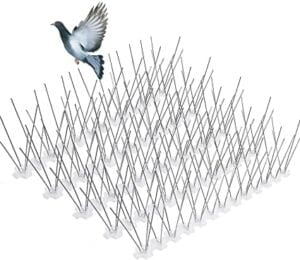


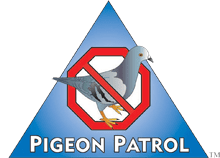


![Building Product: No Knot Bird Netting - [10203b8] | ARCAT](https://www.arcat.com//photos/birdbgon/132024.jpg)






